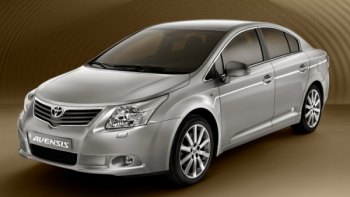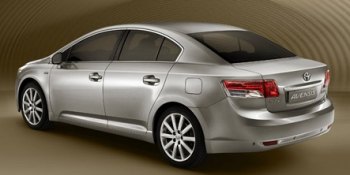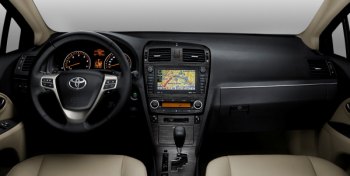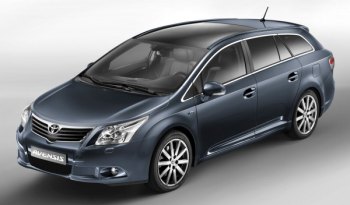|

|
Toyota tries to break into European
D-segment again with its new Avensis...
|
Toyota
produces the world’s widest range of vehicles. Nearly in all segments
it has at least one – sometimes multiple – competitive contender. For
example, in city car segment it has Vitz (one of the top sellers in
Japan), in family car segment it has Corolla (world’s best selling
car), large family car it has Camry (America’s best selling car),
luxury class it has Lexus (best selling luxury brand in USA). However,
until now it has yet to make any significant impact on the European
mid-size car segment. Toyota took this segment seriously since 1998,
when it started producing Carina in its UK plant. By 2003 the Carina
went into history and was replaced by the first generation Avensis,
whose design and engineering was further localized to suit the taste of
European drivers. Unfortunately, the European market has been highly
competitive, with good cars like Ford Mondeo, Volkswagen Passat,
Citroen C5, Mazda 6, Honda Accord, Opel Vectra (now Insignia), Renault
Laguna, Peugeot 407, Skoda Superb etc. to rival in a shrinking segment.
Obviously, the outgoing Avensis was not good enough to take any
success.
One of the biggest problems of the old car was its conservative looks.
The second generation continued to be designed by Toyota’s ED2 studio
in Southern France, but its design is far more radical. The sedan
version has a fast windscreen and rear screen, a crisp shoulder line
and pronounced wheelarches to deliver a sporty feeling. The tail has
strong similarity to Lexus IS, which means sporty yet elegant. The side
view is the most attractive, as you can see its sporty profile clearly.
Unfortunately, the good design is ruined by the odd-looking headlamps
(why are they so large ?) and the fussy front mask. You know, without
a pretty face, a girl will never win Miss World title no matter how
sexy
her body looks.

|
The new Avensis continued to be
designed by Toyota’s ED2 studio in Southern France, but its design is
far more radical...
|
The new
Avensis is
built on an updated version of the previous platform utilizing
suspensions consisting of MacPherson struts up front and
double-wishbones at the rear. While its wheelbase remains a rather
short 2700 mm, its length and width are both increased by 50 mm.
Brilliantly, it managed to weigh only 10 kilograms more than the
equivalent old car without resorting to any aluminum parts. Admittedly,
the old car was criticized as overweight, so keeping the same weight
won’t be too difficult. Like other new cars in the class, the Toyota
feels solidly built and the assembly quality from the UK plant follows
the same standard as in Japan. You won’t feel any differences.
Benefited by the extra width, the cabin is noticeably wider, capable of
sitting 3 regular size adults at the back. Legroom is also surprisingly
good for its short wheelbase, but it fails to match the much larger
Ford Mondeo of course. You are unlikely to be impressed by the dull
design of the dashboard (this is still a conservative Toyota). The
plastics and the faux bamboo material on the center console are far
more satisfying than those in the old car, but the same can be said to
any rivals, say, from the old Mondeo to the new Mondeo. Unlike
Volkswagen, or to lesser extent Renault, it does not have a specially
high-quality feel. Poorest of all is the uncomfortable driver seat,
which causes backache after long journey. On the positive
side, the availability of panoramic glass roof and a large and flat
load bay in the Touring (estate) are welcomed.

|
The plastics and faux bamboo material
are far more satisfying than those in the old car, but the same can be
said to any rivals...
|
The Avensis
provides
3 petrol engines from the same family. They displace 1.6, 1.8 and 2.0
liters. Dual-VVT-i (variable cam phasing at both intake and exhaust
valves) and new Valvematic (variable intake valve lift, which not only
enhances breathing at high rev but also reduces pumping loss at
part-load due to partially-closed throttle butterfly) enable
remarkable output at 132hp, 147hp and 152hp respectively. The
1.8-liter is the best compromise among them as it is smooth and
flexible. However, a
small turbocharged engine would have provided even stronger torque yet
return lower fuel consumption and help saving our earth. Toyota has
missed a chance to demonstrate its green commitment.
Apart from petrol engines, Avensis does not forget
to offer diesel engines to the European market of course. There are 3
D4-D turbo diesel
engines – 126hp / 221lb-ft 2.0-liter, 150hp / 251lb-ft 2.2-liter
and 177hp / 276lb-ft 2.2-liter. All employ third generation
common-rail injection system with 2000 bar pressure to increase output
and reduce fuel consumption. Apart from the excessive noise at high rev
for the 2.0 D4-D, they are as good as the best diesel engines being
offered by European rivals. Compare with petrol, the diesel engines
provide better
real world performance and flexibility yet achieve higher mileage and
lower emission. For example, 2.0 D4-D achieves 55.3 mpg in European
combined cycle, versus 43.4 mpg of the 1.8 VVT-i. It emits 134 grams of
CO2 per kilometer, 20 grams less than the
petrol. Choosing the diesel
over petrol engine has one more advantage: thanks to the superior
bottom end torque, you don’t need to work hard on the 6-speed manual
gearbox. For the petrol Avensis, customers who want to drive relaxingly
must choose the “Multidrive S” CVT, as no automatic gearbox is offered.

|
The availability of panoramic glass
roof and a large and flat load bay in the Touring (estate) are
welcomed...
|
The new
Avensis is
still developed primarily in Japan. However, 35 engineers from Toyota’s
European R&D center took part in the development programme and
tuned its driving dynamics on European roads. Once you drive the car,
you will see
those 35 engineers must be fell asleep or got lost in the
Japanese-style English conversation. From the soft suspension
(which leads to excessive roll), strong biasing towards high-speed
stability instead of cornering agility, or the precise but
uncommunicative steering, you will be hard to tell which element is
influenced by European engineers. In fact, it drives just like a
traditional Toyota engineered in Japan - safe but uninspiring.
Moreover, we have some reservation about its refinement. On poor roads
the suspensions transmit too much harshness and noise into the cabin.
On highway a fair degree of wind noise enters from the base of the
windscreen. These flaws should not happen in a Toyota.
With this Avensis Mk2, Toyota once again fails to break into the
European mid-size car segment. |